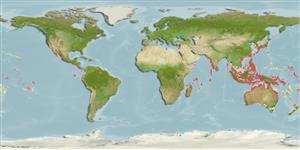Common names from other countries
>
Anguilliformes (Eels and morays) >
Ophichthidae (Snake eels) > Ophichthinae
Etymology: Ophichthus: Greek, ophis = serpent + Greek, ichthys = fish (Ref. 45335).
More on author: Kaup.
Environment: milieu / climate zone / depth range / distribution range
Ecologia
marinhas demersal; intervalo de profundidade 2 - 20 m (Ref. 89972). Tropical
Indo-Pacific.
Tamanho / Peso / Idade
Maturity: Lm ? range ? - ? cm
Max length : 120 cm TL macho/indeterminado; (Ref. 89972)
Descrição suscinta
Chaves de identificação | Morfologia | Morfometria
Vértebras: 177 - 179. Color tan to brown; larger specimens becoming darker above lateral midline and its median fins with black margin; pectoral fins dark; those of smaller specimens may be clear. A prominent pale spot before eye and a smaller pale spot on snout above anterior nostril. Barbels prominent along ventral margin of upper lip; one beneath the anterior margin of the eye, the other midway between it and the base of the anterior nostril. Dorsal fin elevated , its origin just above or slightly in advance of gill openings. Pectoral fins elongate, 2.4-2.8 HL.
A benthic (Ref. 75154) and burrowing species which occurs over soft bottoms of inshore waters (Ref. 7300, 75154). Feeds on cephalopodes, crustaceans and small fishes (Ref. 89972). Solitary in sand, often with head protruding (Ref 90102).
Ciclo de vida ou comportamento de acasalamento
Maturities | Reprodução | Spawnings | Egg(s) | Fecundities | Larvas
McCosker, J.E. and J.E. Randall, 2002. Ophichthys melanochir Bleeker, 1865, a junior synonym of the highfin snake eel Ophichthus altipennis (Kaup, 1856). Copeia 2002(3):798-799. (Ref. 43769)
Status na Lista Vermelha da UICN (Ref. 130435)
CITES (Ref. 128078)
Not Evaluated
Ameaça para os humanos
Harmless
Uso pelos humanos
Pescarias: sem interesse
Ferramentas
Relatórios especiais
Baixar XML
Fontes da internet
Estimates based on models
Preferred temperature (Ref.
115969): 24.1 - 29.2, mean 28.4 (based on 3045 cells).
Índice de diversidade filogenética (Ref.
82804): PD
50 = 0.5000 [Uniqueness, from 0.5 = low to 2.0 = high].
Bayesian length-weight: a=0.00089 (0.00039 - 0.00204), b=3.00 (2.80 - 3.20), in cm Total Length, based on LWR estimates for this (Sub)family-body shape (Ref.
93245).
Nível Trófico (Ref.
69278): 4.1 ±0.7 se; based on size and trophs of closest relatives
Resiliência (Ref.
120179): médio(a), tempo mínimo de duplicação da população 1,4 - 4,4 anos (Preliminary K or Fecundity.).
Fishing Vulnerability (Ref.
59153): High to very high vulnerability (72 of 100).
